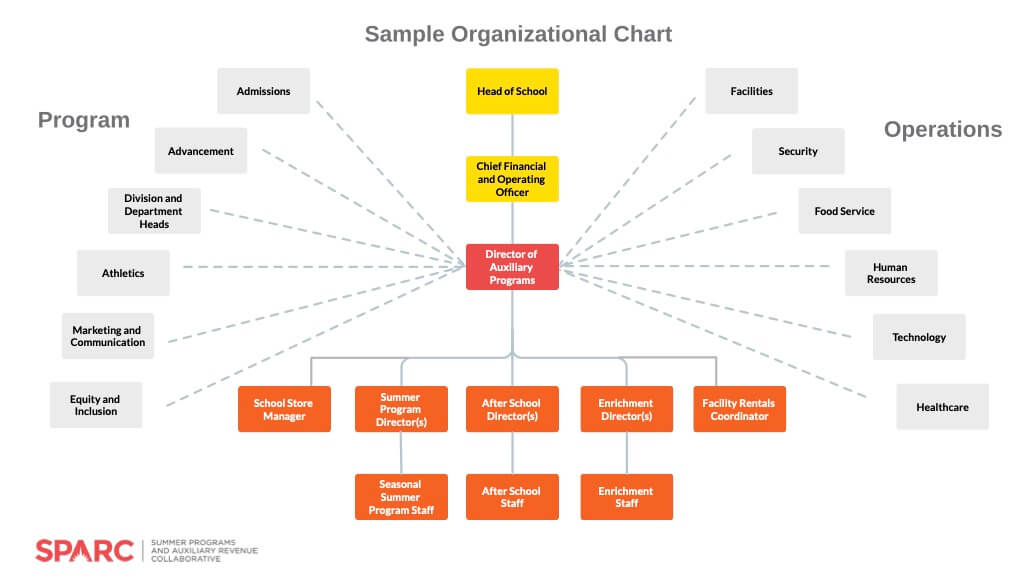Breaking Down Silos: Turn Your Org Chart Into a Collaboration Map

“A lot of departments can function within that dysfunction of siloed environments, even if they’re not happy about it," said SPARC Senior Advisor David Sullivan in our recent roundtable, "Breaking Down Silos: Building Cross-Department Collaboration for Auxiliary Success." But for auxiliary, it's difficult to thrive without partnering with other departments, requiring directors to reach out and form relationships within their school. "I often think the state of health of a school can be viewed by how well auxiliary is being supported and recognized by other departments.”
Auxiliary's strong presence in school culture--summer, after school, enrichment, rentals, school stores, etc.--means they are often the most familiar and frequent touch point families have with the school at large. This makes them uniquely placed to support and partner with admissions, advancement, alumni relations, faculty, and more.
Understanding the vital importance of auxiliary's need to build relationships, SPARC developed the organizational chart above to assist directors in identifying and reaching out to key departments to communicate, partner, and collaborate. This chart is not just an image of a school hierarchy--it's a relationship map. Every dotted line is an opportunity to build connection, shared value, and mission-aligned impact.
Strategies for Breaking Down Silos
In our roundtable, auxiliary department leaders identified several common difficulties created by siloed-off departments, including not having a realistic understanding of what auxiliary does, territorial behavior/siloed mindsets, lack of operational alignment--overscheduling space and facilities, little or no event coordination--last minute requests that are difficult for auxiliary to accommodate, and lack of information to allow auxiliary to plan and prepare.
Participants then shared their tried-and-tested strategies for tearing down the figurative walls that separate departments:
- Reach out to other department heads to schedule one-on-one coffees, lunches, or meetings. Getting to know each other as colleagues--putting a face to the name--goes a long way toward creating good will.
- Share your vision and the unique ways in which auxiliary can support their department. Explain the "auxiliary mindset"--how you bring the magic to events; your expertise in handling traffic patterns, lines, and crowds; how you can help with last-minute gifts, pictures and videos, even costumes for events like Spirit Week.
- Ask them about their vision and what support they need. How can you collaborate to create healthy, sustainable partnerships?
- Get into team meetings for information about how the kids' day went--who had to go home? Who is struggling? Learn about any problems before after school begins to prepare for any family questions.
- Ask to be included in planning discussions from the outset so you can properly prepare for staffing, scheduling, inventory, etc.
- Create a shared calendar, such as in Google docs, to avoid confusion over event planning and scheduling shared spaces. Create your SPARC Compass and keep it up to date.
What's Working--How Auxiliary Leaders are Building Relationships
Roundtable participants shared a number of ways they reach out, share with, and support other departments to build thriving relationships:
Bagels Build Bridges: Host informal breakfasts with facilities, security, or food service teams to build rapport.
Swag for Support: Create “Camp Crew” shirts for maintenance staff who help with summer set-up. (One participant said their maintenance team "loved" their summer t-shirt swag!)
Celebrate Together: Invite faculty and staff to participate in camp talent shows or field days—they become ambassadors when they’re involved.
Co-Promote: Work with marketing to highlight auxiliary wins as a value-add in admission materials.
Train With Purpose: Collaborate with DEI, IT, and Health to co-lead relevant sessions during summer staff training.
SPARC Tools: How We Can Help
In addition to watching the video of this roundtable, SPARC offers valuable tools and resources to support your in-school partnerships.
Download a PDF of the chart above. Use it to identify partners; take it to your HOS or CFO to illustrate the importance of auxiliary collaborating throughout the school.
Visualize and plan your entire year and share it with other departments.
Internal Relationship Assessment Tool
Rate and reflect on your connections across campus.
Rate and rank your strategic priorities to strengthen communication and shared goals.
"Transform Your Auxiliary Programs With the Power of Partnerships"
Blog post detailing strategies for creating and sustaining healthy partnerships both within the school and in the community.
Reach out to our amazing community of auxiliary professionals for advice, support, and ideas!
Karen McCann McClelland contributed to this article.
With regular roundtables, professional development webinars, tools for planning and strategizing, and a community of peers offering unparalleled support, SPARC is your destination for all things auxiliary. Become a member today and enhance the value you bring to your programs and school!
